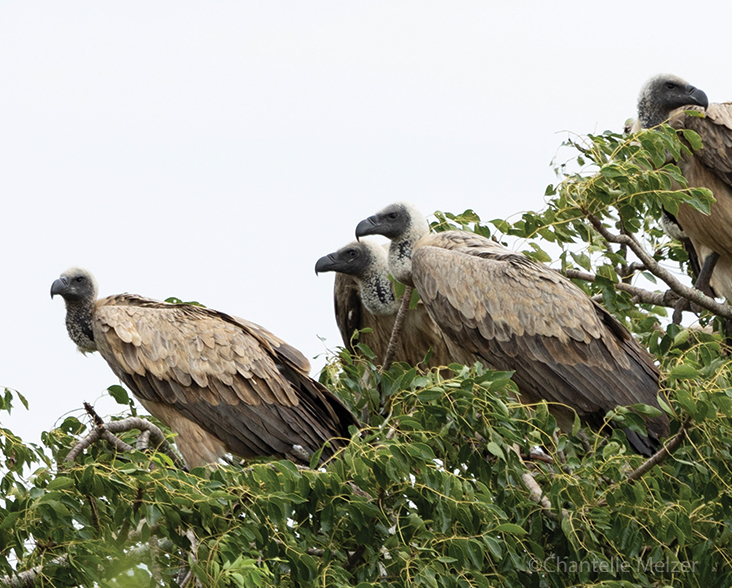White-backed Vulture
Species Data
Class: Aves
Order: Accipitriformes
Family: Accipitridae
Scientific Name: Gyps africanus
IUCN Red List status: Critically Endangered
DESCRIPTION
A medium-sized vulture, 94 cm in length with a wingspan of 218 cm and a short tail. Adults are similar in size and appearance, mostly uniform brown to buff (older individuals often paler cream) on the upperparts, underparts, upper lesser and median coverts, and uppertail coverts, with a white rump. The greater coverts and flight feathers are blackish-brown with contrasting white underwing coverts visible in flight. The bald black skin on the head and neck is sparsely covered in short whitish or cream down, with a short white downy ruff at the base of the neck. The long strong bill, cere, and legs are blackish, and the eyes are blackish-brown.
Juveniles are darker brown and finely streaked with a straggly brown ruff, brown rump, and greenish-black skin on the head and neck, more densely covered in white down. At 10-12 months, juveniles moult into immature plumage, over 6-7 years, gradually becoming paler brown, with the ruff, rump and wing-linings turning white.
BEHAVIOUR
White-backed Vultures are scavengers, feeding mostly on carrion from large dead mammal carcasses, which they locate by rising on thermals 2-3 hours after dawn and soaring over great distances at around 200-500 m above ground watching the behaviour of mammalian and other avian scavengers and predators, also entering human settlements to search for dead livestock. The White-backed Vulture is a gregarious species, roosting in small groups and gathering in tens to hundreds at a single large carcase such as an Impala, which they can strip bare within 10 minutes. Their bill cannot tear thick skin but the bare head and long neck are perfectly adapted for probing deep into wounds to access flesh.
Breeding occurs year-round but mainly between October-June in West Africa and April-January in East and southern Africa, with egg laying occurring most often at the start of the dry season. Pairs are monogamous and breed once a year, usually nesting in loose colonies of 5-20 pairs, although sometimes singly. The nest is relatively small, 34-100 cm in diameter, built of sticks and lined with grass and green leaves, situated 5-50 m in the crown of tall trees often along water courses, and in South Africa, occasionally also on pylons. Both adults incubate the single egg (rarely 2-3) for 56-58 days and feed the chick. After 120-130 days the young fledges and both parents continue to feed it for several months until it eventually disperses.


HABITAT
This species occurs in open woodlands, savannas, steppes, open swamps, riverine trees, and thornbush. Mostly in lowlands from sea-level to 1,500 m, but recorded up to 3,500 m in Ethiopia. Found around cattle ranches and nomadic herders, but not in urban areas.
Remains the most common and widespread vulture in sub-Saharan Africa, found from Senegal in the west to western Somalia in the east, south through East Africa to northern South Africa and Namibia, but absent from the Congo basin
THREATS AND CONSERVATION
The White-backed Vulture has undergone an extremely steep decline across much of its range. The global population was estimated at 270,000 individuals in 1992 but has crashed by 81% in the following 40 years. Declines will likely continue; therefore, the White-backed Vulture is listed as Critically Endangered on the IUCN Red List.
Intentional and unintentional poisoning is the biggest cause of declines in East Africa, especially from diclofenac used in livestock, with unintentional poisoning of carcasses accounting for up to 25% of annual mortalities. Declines in wild ungulate populations in East and West Africa have reduced the availability of carcasses for feeding while hunting in southern Africa for medicinal purposes and illegal international trade in West and Central Africa in body parts for traditional juju is a major threat, despite this species listed in CITES Appendix II. Additional threats include loss of habitat to agropastoralism, improved carcass disposal, electrocution on powerlines, collisions with road traffic, wind energy development, and natural gas exploration.
Protected areas provide some protection for White-backed Vultures, although the large home ranges of this species take them outside of these areas and increase the risk of poisoning. The White-backed Vulture is included in a Multi-species Action Plan to conserve African and Eurasian vultures and reduce vulture mortality, with actions that include establishing a framework to implement the plan, further research into vulture population sizes, trends, ecology and threats, education and awareness, and reducing vulture mortality.
